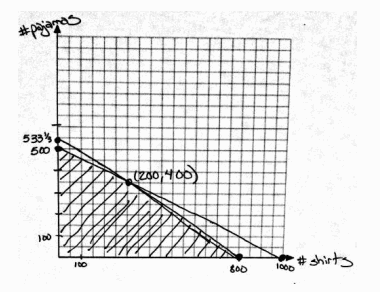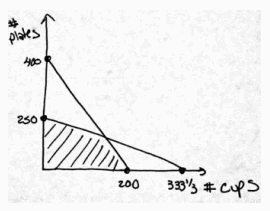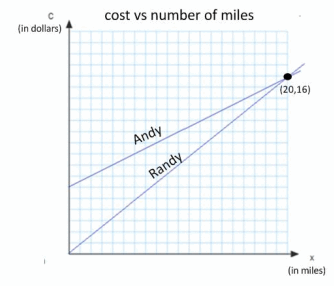Engage NY Eureka Math Algebra 1 Module 1 Lesson 24 Answer Key
Eureka Math Algebra 1 Module 1 Lesson 24 Example Answer Key
Example
Lulu tells her little brother, Jack, that she is holding 20 coins, all of which are either dimes or quarters. They have a value of $4.10. She says she will give him the coins if he can tell her how many of each she is holding. Solve this problem for Jack.
Answer:
Let d= the number of dimes, and let q= the number of quarters.
d+q=20
0.10d+0.25q=4.10
Lulu is holding 6 dimes and 14 quarters.
Eureka Math Algebra 1 Module 1 Lesson 24 Opening Exercise Answer Key
Opening Exercise
In Lewis Carroll’s Through the Looking Glass, Tweedledum says, “The sum of your weight and twice mine is 361 pounds.” Tweedledee replies, “The sum of your weight and twice mine is 362 pounds.” Find both of their weights.
Answer:
Let x= the number of pounds Tweedledee weighs, and let y= the number of pounds Tweedledum weighs.
x+2y=361
y+2x=362
Tweedledum weighs 120 pounds, and Tweedledee weighs 121 pounds.
Eureka Math Algebra 1 Module 1 Lesson 24 Exploratory Challenge Answer Key
Exploratory Challenge
a. At a state fair, there is a game where you throw a ball at a pyramid of cans. If you knock over all of the cans, you win a prize. The cost is 3 throws for $1, but if have you an armband, you get 6 throws for $1. The armband costs $10.
i. Write two cost equations for the game in terms of the number of throws purchased, one without an armband and one with.
Answer:
Let x = number of throws, and let C= cost.
Without armband: C=\(\frac{1}{3}\) x
With armband: C=\(\frac{1}{6}\) x+10
ii. Graph the two cost equations on the same graph. Be sure to label the axes and show an appropriate scale.
Answer:
See graph at right.

iii. Does it make sense to buy the armband?
Answer:
Only if you want 60 or more throws.
Point out the constraints of x. Without the armband, x must be a multiple of 3; with the armband, x must be a multiple of 6.
Remind students about discrete and continuous graphs. The graphs of each equation should actually be discrete rather than continuous. Discuss why other points on the graph would not make sense for this scenario.
b. A clothing manufacturer has 1,000 yd. of cotton to make shirts and pajamas. A shirt requires 1 yd. of fabric, and a pair of pajamas requires 2 yd. of fabric. It takes 2 hr. to make a shirt and 3 hr. to make the pajamas, and there are 1,600 hr. available to make the clothing.
i. What are the variables?
Answer:
Number of shirts made and number of pajamas made.
ii. What are the constraints?
Answer:
How much time the manufacturer has and how much material is available.
iii. Write inequalities for the constraints.
Answer:
Let x= number of shirts, and let y= number of pajamas.
x≥0 and y≥0
x+2y≤1000
2x+3y≤1600
iv. Graph the inequalities and shade the solution set.
Answer:

v. What does the shaded region represent?
Answer:
The various combinations of shirts and pajamas that it would be possible for the manufacturer to make.
vi. Suppose the manufacturer makes a profit of $10 on shirts and $18 on pajamas. How would it decide how many of each to make?
Answer:
The manufacturer wants to make as many as possible, so the maximum should be at one of the endpoints of the shaded region.
vii. How many of each should the manufacturer make, assuming it will sell all the shirts and pajamas it makes?
Answer:
Profit =10x+18y

He should make 200 shirts and 400 pairs of pajamas for a maximum profit.
→ Why does this scenario call for inequalities rather than equations?
→ He cannot exceed the amount of time or material available but does not necessarily have to use all of it.
→ The shaded region in a problem of this type is sometimes called the feasible region. Why does this name make sense?
→ This is the region that represents the number of shirts and pajamas that he can feasibly make given the constraints.
Students should intuitively believe that the maximum profit should be at one of the endpoints of the shaded region (which is true because he is maximizing the given resources). However, you can have students test other points to prove that intersection point is, in fact, the maximum.
Eureka Math Algebra 1 Module 1 Lesson 24 Problem Set Answer Key
Question 1.
Find two numbers such that the sum of the first and three times the second is 5 and the sum of the second and two times the first is 8.
Answer:
The two numbers are \(\frac{19}{5}\) and \(\frac{2}{5}\) .
Question 2.
A chemist has two solutions: a 50% methane solution and an 80% methane solution. He wants 100 mL of a 70% methane solution. How many mL of each solution does he need to mix?
Answer:
The chemist should use 33 \(\frac{1}{3}\) mL of the 50% solution and 66 \(\frac{2}{3}\) mL of the 80% solution.
Question 3.
Pam has two part-time jobs. At one job, she works as a cashier and makes $8 per hour. At the second job, she works as a tutor and makes $12 per hour. One week she worked 30 hours and made $268. How many hours did she spend at each job?
Answer:
She worked at the cashier job for 23 hours and tutored for 7 hours.
Question 4.
A store sells Brazilian coffee for $10 per lb. and Columbian coffee for $14 per lb. If the store decides to make a 150-lb. blend of the two and sell it for $11 per lb., how much of each type of coffee should be used?
Answer:
They should use 112 \(\frac{1}{2}\) lb. of Brazilian coffee and 37 \(\frac{1}{2}\) lb. of Columbian coffee.
Question 5.
A potter is making cups and plates. It takes her 6 min. to make a cup and 3 min. to make a plate. Each cup uses \(\frac{3}{4}\) lb. of clay, and each plate uses 1 lb. of clay. She has 20 hr. available to make the cups and plates and has 250 lb. of clay.
a. What are the variables?
Answer:
c= # of cups made
p= # of plates made
b. Write inequalities for the constraints.
Answer:
c≥0 and p≥0 and \(\frac{1}{10}\) c+\(\frac{1}{20}\) p≤20 and \(\frac{3}{4}\) c+p≤250
c. Graph and shade the solution set.
Answer:
See graph at right.

d. If she makes a profit of $2 on each cup and $1.50 on each plate, how many of each should she make in order to maximize her profit?
Answer:
120 cups and 160 plates
e. What is her maximum profit?
Answer:
$480
Eureka Math Algebra 1 Module 1 Lesson 24 Exit Ticket Answer Key
Andy’s Cab Service charges a $6 fee plus $0.50 per mile. His twin brother Randy starts a rival business where he
charges $0.80 per mile but does not charge a fee.
Question 1.
Write a cost equation for each cab service in terms of the number of miles.
Answer:
Let x= number of miles, and let C= cost.
Andy’s: C=0.5x+6
Randy’s: C=0.8x
Question 2.
Graph both cost equations.

Answer:
See graph.

Question 3.
For what trip distances should a customer use Andy’s Cab Service? For what trip distances should a customer use Randy’s Cab Service? Justify your answer algebraically, and show the location of the solution on the graph.
Answer:
0.5x+6=0.8x
x=20
If the trip is less than 20 miles, use Randy’s. If the trip is more than 20 miles use Andy’s. If the trip is exactly
20 miles, either choice will result in the same cost.